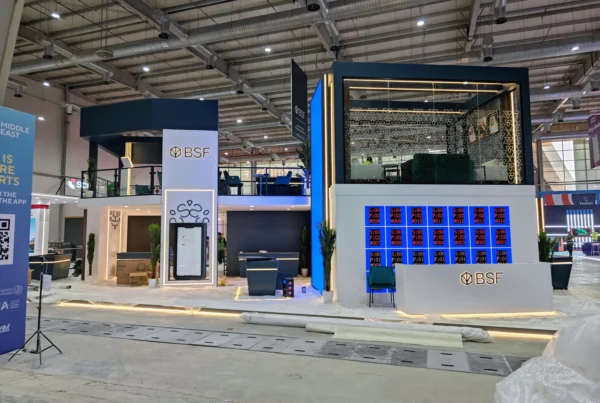As audiences grow more sophisticated, delivering a digital interactive experience that resonates with every individual user is swiftly becoming an industry standard. Whether you’re producing an immersive event or showcasing off-plan real estate to international buyers, personalized interactions stand out from generic, one-size-fits-all approaches. By 2025, advances in AI, user profiling, and cutting-edge sensors will expand this personalization into real-time environments—driving emotional connections and boosting ROI across events, retail, and real estate marketing.
In this article, we’ll dissect how hyper-personalization transforms user journeys, detail the technologies underpinning these experiences, and explore best practices and ethical considerations. From major conferences seeking to refine attendee engagement to real estate professionals aiming to accelerate property sales, hyper-personalization can pay dividends by forging deeper relationships and memorable encounters.
1. Defining Hyper-Personalization in 2025
1.1 Moving Beyond Basic Personalization
Where traditional personalization might display a user’s name on a website or recommend a product based on past purchases, hyper-personalization leverages real-time data—like biometric feedback, facial expressions, or AI-driven analytics—to adapt everything from music volume and lighting to recommended content. This can include something as simple as showing session suggestions based on an attendee’s role at a conference to something as advanced as a digital twin for real estate that adapts room layouts based on a potential buyer’s style preferences.
Key to this transformation is harnessing a blend of advanced AI, sensor technologies, and modular software architecture that reacts instantly to user input. As the EventMB Guide to Event Engagement underscores, engaging attendees on a personal level can amplify event impact, increase dwell time, and support strong word-of-mouth marketing.
1.2 Cross-Industry Relevance
- Events: Large expos, conferences, or brand activations thrive on capturing each guest’s attention through curated pathways, chatbots, or interactive signage.
- Real Estate: Properties can be pre-sold and customized virtually, with “smart tours” adjusting visuals, highlighting relevant amenities, or adjusting lighting to suit buyer preferences.
By 2025, this approach no longer belongs to tech enthusiasts alone; it’s fast becoming a mainstream expectation. As How Meetings and Events Can Leverage Personalization elaborates, personalization fosters higher conversions, more memorable brand impressions, and stronger attendee loyalty.
2. Core Technologies Powering Hyper-Personalization
2.1 AI & Machine Learning
Artificial intelligence—particularly machine learning—forms the backbone of advanced personalization. Algorithms predict user tastes or behaviors based on aggregated data, enabling real-time decisions. For instance, an AR-based property showroom might note which design elements a user lingers on and immediately offer accessories matching their style preferences. The McKinsey Technology Trends Outlook 2022 – Immersive Reality report explores how such advanced analytics shape everything from user experience to brand trust.
2.2 User Profiling & Behavioral Insights
By analyzing user traits—demographics, event registration data, or browsing history—brands can tailor content. For events, this may include delivering curated session lineups. In real estate, digital twin models might reveal a custom interior layout that aligns with a buyer’s budget and design preferences. Tools like chatbots, voice assistants, and interactive signage rely on these user profiles to deliver meaningful interactions.
2.3 Advanced Sensors & Biometric Feedback
High-precision cameras can track facial expressions, while wearable devices read biometrics (heart rate or stress levels). If an attendee appears disengaged, an AI-driven kiosk or session might adapt by highlighting more dynamic content. The link between biometric data and immersive technology is elaborated in AI Takes Center Stage: How 2025’s AI Revolution Will Transform the Digital Interactive Experience, describing how on-the-fly adaptation can bridge emotional resonance.
2.4 Real-Time Content Management Systems
On the software side, real-time rendering engines (like Unreal or Unity) work alongside AI modules. This combination ensures that each user sees an environment that’s relevant and updated within seconds. In events, a brand’s keynote visuals might morph based on live sentiment analysis, while real estate digital twins can shift property highlights according to occupant data.
3. AI in Action: Adaptive Environments and Personalized Content
3.1 Immersive Events: Unique Journeys for Each Attendee
Imagine arriving at a conference where AR signage greets you by name (if you’ve consented), invites you to an exclusive networking lounge, or suggests workshops based on your professional background. The 20 Bright Ideas for Personalizing Attendee Experiences highlights how small touches—like custom agendas, recommended dining spots, or interactive contests—encourage participants to feel recognized, driving repeat attendance and social buzz.
3.2 Adaptive Real Estate Showrooms
For prospective buyers exploring a digital twin (see The Rise of Digital Twin in Real Estate: From Concept to Industry Standard), advanced user profiling can detect if the visitor is a family searching for multi-bedroom units or a professional seeking a sleek condo. The system automatically highlights relevant floor plans, recommended finishing styles, or nearby amenities. The result: an intuitive property exploration that fosters faster, more confident decisions.
3.3 Personalized Storytelling through Metahumans
Metahumans—lifelike digital characters discussed in The Metahuman Roadmap: Future Trends Shaping Immersive Event Solutions—can greet event attendees or real estate clients in VR. Through AI-based conversation, these personas adapt their script based on user queries or emotional cues, forging a more “human” connection. This synergy intensifies brand recall and user satisfaction.
4. Boosting Emotional Resonance and Engagement
4.1 From One-Way to Two-Way Communication
Traditional slideshows and static booths often feel one-sided. In a hyper-personalized setting, however, each user’s reaction triggers changes in content—be it an on-screen animation that intensifies during excitement or a VR environment morphing to match the user’s mood. This sense of collaboration fosters emotional ties, as the user feels directly involved in shaping the experience.
4.2 Multisensory Design
When visuals, soundscapes, and tactile elements shift in tandem with user data, the result is an elevated emotional response. For instance, an interactive LED wall might intensify certain colors if biometric sensors detect high excitement, increasing the immersive effect. Insights from the EventMB Guide to Event Engagement mention such multi-layered engagements as prime drivers for event success.
4.3 Real-Time Adaptation for Real Estate Buyers
Nothing cements emotional resonance more powerfully in real estate than letting a client configure an apartment layout, furniture, or lighting in a digital twin environment, with instant visual feedback. This approach not only speeds the sales process but also allows them to “own” the customization, forging an emotional link to the property.
5. Why Hyper-Personalization Delivers Higher Returns
5.1 Direct Conversion Growth
Studies show that relevant content boosts conversion rates and shortens decision time. A potential buyer who sees an apartment scheme precisely tailored to her budget or style is more likely to make a quick deposit. An event attendee who sees only relevant sessions invests more time exploring brand activations, raising the chance of a lead.
5.2 Reinforced Brand Loyalty
Feelings of personal connection encourage repeat visits. Recurring expos or ongoing property model updates provide continuous user-specific enhancements, maintaining a pipeline of loyal fans. According to How Meetings and Events Can Leverage Personalization, personal touches give attendees reasons to advocate for the event or brand, extending the marketing reach.
5.3 Immediate Data-Driven Optimization
Every user interaction is a data point. By tracking dwell time, gestures, emotional states, or the modules used, teams can fine-tune experiences in real time, ensuring resources are directed where they yield the best returns. This iterative cycle underpins the entire concept of AI-fueled personalization.
6. Implementation Roadmap: Events and Real Estate
6.1 For Event Professionals
- Pre-Event Profiling: Collect attendee info at registration, gleaning roles and preferences.
- Dynamic Session Suggestions: Real-time analytics recommend sessions based on user engagement or background.
- Adaptive Content: Immersive technologies (see Immersive Interactive Technology for Events) that shift based on sentiment detection or user flow.
- Post-Event Retargeting: Follow-up communications reference the user’s actual event path, fueling further brand relationship.
6.2 For Real Estate Developers
- Smart Digital Twins: Enhance properties with AI that modifies interiors or clarifies cost implications, building trust. The Deloitte report on digital twins highlights the potential for cost savings and accelerated decisions.
- User-Driven VR/AR Tours: Let visitors pick finishes or explore different apartment styles, then adapt subsequent offerings to match.
- Data Integration: Linking occupant analytics with property management systems fosters ongoing personalization for existing tenants, improving satisfaction and occupancy rates.
6.3 Overall Steps
- Define Objectives: Clarify if your end goal is direct sales, brand awareness, or occupant convenience.
- Select Technology: Evaluate real-time engines, sensor setups, or AI chatbots.
- Plan Pilots: Test on a smaller scale—like a limited VR corner or partial digital twin—before full rollout.
7. Data Privacy & Ethical Considerations
7.1 Handling Sensitive Data
Capturing facial expressions or biometric signals can alarm users if not clearly disclosed. A robust consent mechanism, accompanied by transparent data usage policies, ensures users aren’t left feeling spied upon. This compliance is especially crucial in real estate showrooms that track occupant footprints for predictive maintenance or usage analytics.
7.2 Avoiding Over-Personalization Fatigue
Push personalization too far, and you risk appearing invasive or “creepy.” Brands must find a balance: enough adaptation to show care and convenience, but not so granular as to alienate customers.
7.3 Building Trust
As the McKinsey Explainer: What is digital-twin technology? suggests, ensuring transparency about data collection and usage fosters trust, a cornerstone of any positive user experience.
8. Technical & Operational Challenges
8.1 Infrastructure & Latency
Hyper-personalization involves immediate reactivity, so heavy loads on servers or networks can stall experiences. Solutions like on-site edge computing or advanced cloud infrastructure can reduce lag.
8.2 Skill Sets
A balanced team of AI researchers, real-time 3D developers, and user-experience designers is essential. Overcoming the shortage of specialized talent may require external vendors or partnerships.
8.3 Cost vs. Scale
While personalization yields impressive user engagement, a robust system capturing, processing, and rendering data in real time can be expensive. Starting with modular design (as in Future Trends: UE5.5, GeForce GTX 5000, and the Next Wave of Digital Twin for Real Estate and Events) helps you expand gracefully without overspending.

9. Case Studies & Success Stories
9.1 AR-Infused Brand Expo
A consumer tech expo introduced wearables and AR interactions that used AI to guess user interest based on micro-expressions. Attendees reported feeling “understood,” leading to a 25% spike in lead captures. These ideas align with the “bright ideas” in 20 Bright Ideas for Personalizing Attendee Experiences.
9.2 Digital Twin for Real Estate with Sensor Inputs
Developers launched a partial digital twin for a mixed-use building, linked to occupant preference data. If a buyer lingered on certain finish options, the system automatically suggested complimentary design elements. This shortened pre-sales cycles and boosted user confidence. For more on digital twin frameworks, see What is digital-twin technology?.
9.3 AI Chatbots in Retail
A store integrated AI chatbots with dynamic signage (Smart Digital Signage Revolution for T-Mobile). Customers walking by a display triggered real-time product recommendations or localized promotions. Sales soared, and brand recall improved, highlighting the synergy of personalization with data analytics.
10. Future Outlook: Next Steps in Hyper-Personalization
10.1 Deeper Biometric Integrations
Emerging tools could sense subtle emotional shifts, adjusting everything from audio frequency to product suggestions. Used ethically, these readings amplify user comfort and brand value.
10.2 AI-Driven Metahumans
Reflecting the leaps in digital personas (see The Metahuman Roadmap: Future Trends Shaping Immersive Event Solutions), AI can further refine the realism of digital spokespeople, delivering truly responsive and emotive interactions in VR or real estate showroom contexts.
10.3 Continuity Across Ecosystems
Going forward, user profiles might move seamlessly among conferences, corporate showrooms, and real estate tours—continuously calibrating experiences while respecting privacy constraints.
Conclusion & Practical Steps
Hyper-personalization in 2025 will help brands tailor the digital interactive experience to individual preferences, bridging the gap between conventional marketing and genuine one-to-one connections. From immersive event technology that responds to biometric feedback to real estate digital twins that align with personal style and budget, adaptive interactions empower companies to stand out.
To integrate hyper-personalization effectively, begin by:
- Defining Clear Objectives: Clarify if you want increased leads, shortened sales cycles, or deeper brand loyalty.
- Implementing Pilot Projects: Test small-scale solutions (like one personalized AR kiosk) and measure impact.
- Choosing Robust Platforms: Evaluate AI frameworks, sensor solutions, and real-time engines that can scale.
- Maintaining Ethical Data Practices: Ensure transparent consent, data security, and unbiased algorithms.
- Iterating Continuously: Use real-time analytics to refine your approach, pivoting swiftly for improved ROI.
Whether hosting a large conference with thousands of attendees or marketing a new property to remote buyers, weaving hyper-personalization into your strategy can unlock stronger emotional bonds and measurable business gains. For more details on implementing interactive tech while balancing budgets, contact Chameleon Interactive or explore relevant insights like Immersive Interactive Technology for Events: The Key to Memorable Brand Experiences and The Rise of Digital Twin in Real Estate: From Concept to Industry Standard. By embracing user-centric innovation, your brand will not only engage audiences more profoundly but also remain at the forefront of next-generation experiences.
FAQ: Hyper-Personalization and the Digital Interactive Experience
1. How does hyper-personalization differ from standard personalization?
Hyper-personalization uses AI, real-time sensor data, and user profiling to adapt content dynamically—far beyond simply showing a name or a past purchase history. This approach can alter displays, music, or product recommendations on the fly, crafting a truly digital interactive experience that responds moment by moment to each attendee’s preferences or emotional states.
2. Can real estate marketing benefit from AI-driven user profiling the same way events do?
Absolutely. By integrating digital twin simulations with occupant data or buyer interests, real estate professionals can offer dynamic property tours. Each visitor can explore layout options or finishes tailored to their style and budget, mirroring the same level of personal adaptation found in immersive event technology.
3. What role do advanced sensors play in customizing experiences in real time?
Cameras, wearables, or facial recognition software can gauge user engagement or emotional cues. If an event attendee appears excited at a particular demo booth, AI can trigger new content or highlight relevant products. In a real estate showroom, sensors might note prolonged interest in a specific design feature, prompting further details or optional upgrades.
4. Is hyper-personalization expensive to implement at large events or for major real estate developments?
Costs vary depending on scope—hardware needs (e.g., AR/VR setups, high-end servers) plus content creation and AI integration. A phased approach—pilot projects and modular design—lets teams validate ROI early, then scale up. By assessing key metrics, you ensure each tech layer delivers tangible engagement or sales benefits.
5. How can organizations handle data privacy concerns when using hyper-personalized solutions?
Transparency is key. Offer clear consent forms explaining data collection—such as facial expressions or location tracking—while detailing how it’s used. Maintaining encrypted storage and limiting data access help preserve user trust. Adopting ethical algorithms also safeguards against bias and overreaching personalization.


